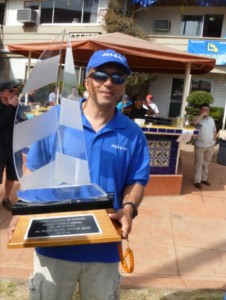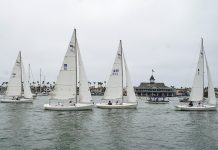Ahoy!
“Sad, very sad, that the Newport to Ensenada race had fatalities on the race course. I do not have enough information and details for this week’s column, however next week I will let you know what happened. To me and other experienced ocean going boaters, it looks like a collision with a ship, but I will find out.”
This was the opening paragraph for my column last week, yet I am still trying to find out what happened to the crew and vessel of the Aegean. However, I will explain my professional scenarios – or, if you will, hypotheses – of what may have happened.

I know the trip from Newport Beach to Ensenada very well, because I was known as the yacht delivery Captain who was delivering the most boats to and from the Hotel Coral. I was traveling two to three times a week, and I have passed the Coronado Islands every other day and dodged the shipping traffic from commercial to military.
I have cruised mostly inside the islands but many times seaward of the islands, due to weather conditions, and believe me, coming uphill with Santa Ana winds that knocks a 60-foot boat at least 20 degrees over does scare the owner aboard. Additionally, I have run in seas bigger than 10 feet with 4-foot wind waves on top while punching past the Coronado Islands.
So what happened to the Aegean? Why does the GPS tracking line go to the island? I am learning that it is a personal locator beacon not an EPIRB, so that changes a lot time lines. Who was wearing the PLB or was it in a sailbag?
First, why is the Navy and Coast Guard not immediately diving on the island and running sonar in the area to find the boat, especially to find the keel, engine, and missing person? If a single-engine airplane had crashed in the area, then the FAA, Coast Guard, and ICE would be activating every asset to find the plane and any missing person(s). Three crew members’ bodies were recovered the day of the incident, April 28, but skipper Theo Mavromatis’ body was not found until last Sunday, by a fisherman.
Also, first reports were that this is being classified as a boating fatality from San Diego, which it is not as this happened in Mexican waters. You might be wondering why this matters. Well, it changes our statistics for safe boating and invites new knee-jerk reactions that will follow from our legislators.
Secondly, this was a seasoned and experienced crew who did not (according to my sources) party hard the night prior at BCYC. Therefore, they could stand the night watch and not fall asleep on the deck. Yet, why did they set their waypoint to an allision with the islands? This was not their first race to Ensenada, so you know when you are getting close to the islands by your GPS chart plotter, and the islands loom on the horizon. I know, because I have been there done that hundreds of times while skippering boats in areas that worried me, and I called everyone on bridge to help be a spotter.
So, what happened?
Hit the island? Feasible, but not probable as there was an experienced crew, everyone would not have died on impact at such a slow speed, and there was no distress signal from anyone.
Hit and run over by a commercial or military ship? Feasible and probable.
Hit the island then bounced off to drift? Feasible, but not probable, as someone would have been able to send a distress signal.
Hit by drug smugglers coming north? Feasible and probable.
Hit by a submarine? Feasible, but not probable, as subs surfacing during a highly congested area during the race would have escort boats nearby.
Abducted by aliens, as someone suggested? Neither feasible nor probable – where do people come up with this stuff?
Tip of the week is that I love Nascar racing, which is safer than sailboat racing. I am watching a race while writing my column, and I think Nascar is in my blood because my Dad’s side of the family is from Ferrum, Va., known as the moonshine capital of the world, and Nascar’s roots are in the moonshine drivers who modified their cars.
I think that I should write a book about the real moonshiners, white lightening, and how to take a sip out of the mason jar.
And don’t forget: Tune in to the No. 1 boating radio talk show in the nation, Capt. Mike Whitehead’s Boathouse Radio Show, broadcasting coast-to-coast on the CRN Digital Talk Radio syndicated network every Saturday at noon, Pacific Time and replayed on Sunday at 10 am Pacific. Join Chandler Bell and me as we talk about “all things boating.” You can find the station listings, cable TV channels, live streaming on the Internet, and now available are apps to listen to the show for your iPhone, Blackberry, iTouch, Android, Palm, and Windows Mobile at www.BoathouseTV.com or www.BoathouseRadio.com.
Until next week, Safe Voyages!





It wasn’t a PLB, it was a SPOT.
A SPOT contains a GPS reciever that computes position which is then transmitted via the GlobalStar satellite constellation to a website. Coordinates are sent when the Okay button is pressed or it can be configured, as in this case, to be automatically sent at 10 minute intervals.
A SPOT also has a SOS button for signaling an emergency.
Alf, give me more information about the SPOT on or offline.
This truly was a tragedy, and still is since there are so many questions unanswered. You’ve made a lot of good points, especially as to why the investigation not ongoing until a conclusion can be reached (or at least narrowed down,) like they would if it was an airplane. I think the families deserve a better understanding as to what happened. Thanks for following this!
The Aegean may have hit the extreme northern end of the island at the vessel’s motoring speed plus the velocity of the swell running that night. The starboard side of the hull at the waterline was breached and the incoming water was forced through the cabin and out the cabin entrance, causing fatal injuries to the three crewmen sleeping below deck. The vessel’s bow was forced downward from the incoming water’s weight, throwing the helmsman into the water where he drowned. Some of the remains of the vessel were carried down the lee side of the island to the southern end where the s/w current battered them against the island and ultimately swept them out to sea where they were discovered by the operator of the Vessel Assist boat at 10:30 am the next morning, almost nine hours after the collision. Two bodies were forced from the wreckage soon after the grounding and recovered with the third that had drowned mixed in the debris field. The fourth body was in the wreck and recently floated free from the portion left intact on the bottom and recovered close by the Middle Grounds where the wreck most likely lies.
The north tip of North Island has good water right to the terminus of the exposed portion of the reef that runs to the north, and eight fathoms within feet of it due east. There is good water down the entire lee with the exception of one exposed rock at the extreme southern tip, and a breach in the island itself just yards north of the that tip that a canoe could navigate, adding another escape route to the s/w for debris to pass.
This may sound far fetched, but it beats the hell out of smugglers, subs, tankers and aliens. An experienced crew takes a well deserved nap before their assigned watches and one crew member on watch cannot stay awake as the vessel makes way down swell. Within seconds of floundering the watchman awakes and find himself going over the railing and into the deep. Three other sailors have no time at all to react to the swell propelled vessel’s bashing against an exposed rock and the incoming sea kills them before any action can be taken.
This scenario explains all the facts so far discovered, as well as the sudden ending of the GPS transmission, the lack of emergency radio transmissions, and the emergence of the floating body on Sunday.
I think some of the wreckage will be found on the lee. I’m sorry for these sailors. nick
Ahoy Nick, do you know what you are implying? Yes, the vessel may have hit the island, but to insinuate that this experienced racing crew did not have a proper watch schedule is beyond belief – I would have had two crewmembers on watch at all times, especially in this short of distance. Do you really think that whoever was on watch did fall asleep? They had only been sailing for 13 plus hours, passing the very busy San Diego Harbor’s commercial and military traffic, watching out for the other couple of hundred sailboats in the race, local fishermen, and then the approaching islands on the horizon. So, you are suggesting that all the blame, which would be gross negligence and not maintaining a proper watch, is placed solely on whoever was on watch. You are saying that he killed every one aboard? Experienced sailors, as those aboard this sailboat, would not fall asleep while on watch, but would have awoken someone else if feeling fatigued, and therefore, unable to maintain a proper lookout. If they hit the island, then there is a lot more to this story, but you should retract your statement of the watch person falling asleep.
I have a SPOT, and I’ve tested its fidelity several times over the past few years. There’s a feature where you can send someone an update of where you are–I find that for whatever reason the accuracy isn’t always ‘spot’ on. Maybe it’s the time lag between when you hit the button and when the person receives the signal, maybe it’s inadequate software or GPS–but my testing shows that the tracking isn’t always accurate. Good enough to let my wife know where I am? Absolutely. Good enough to do a forensic reconstruction of an accident? Not in my opinion…
Captain Mike
Having reviewed hundreds of boating accident reports and looking at damaged boats in the aftermath of accidents, the utter destruction of the Agean to the point that only small pieces remain seems to rule out a normal grounding or even the after effects of meeting a rogue wave. It will be of tremendous value to the boating community to conduct a through investigation of the incident. That should be the responsibility of the Coast Guard.
Until and unless this takes place it behooves all boaters to take special precautions when transiting the area of the accident.
Ray Tsuneyoshi
Hello Captain Mike. I have been following this story with heavy heart. Is there any recent news/discoveries which shed light on how this tragedy came about?